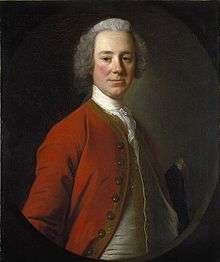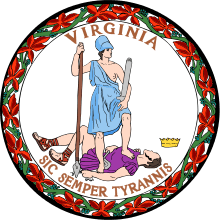John Campbell, 4th Earl of Loudoun
| The Earl of Loudoun | |
|---|---|
 The Earl of Loudoun | |
| Born | 5 May 1705 |
| Died | 27 April 1782 (aged 76) |
| Allegiance |
|
| Service/branch | British Army |
| Rank | General |
| Commands held | North America |
General John Campbell, 4th Earl of Loudoun (5 May 1705 – 27 April 1782) was a British nobleman and army officer.
Early career
Born in Scotland 2 years before the creation of the United Kingdom of Great Britain, Campbell inherited the peerage on the death of his father in 1731, becoming Lord Loudoun. The earl raised a regiment of infantry that took part in the Jacobite Rising of 1745 on the side of the Hanoverian government. The regiment consisted of twelve companies, with Loudoun as colonel and John Campbell (later 5th Duke of Argyll) as lieutenant colonel. The regiment was raised and served in several different parts of Scotland; three of the twelve companies, raised in the south, were captured at Prestonpans. Eight companies, under the personal command of Lord Loudoun, were stationed in Inverness. Loudoun set out in February 1746 with this portion of his regiment and several of the Independent Companies in an attempt to capture the Jacobite pretender, Prince Charles Edward Stuart. The expedition was ignominiously defeated by a small number of Jacobites in what became known as the Rout of Moy. After this debacle, Loudoun fell back to join the Duke of Cumberland's army, giving up the town of Inverness to the rebels.
Seven Years War
North America
In 1756, Loudoun was sent to North America as Commander-in-Chief and Governor General of Virginia, where he was unpopular with many of the colonial leaders. When he learned that some merchants were still trading with the French, while he was trying to fight a war against them, he temporarily closed all American ports. Despite his unpopularity the county of Loudoun, formed from Fairfax in 1757, was named in his honour.[1] As Commander-in-Chief, he planned an expedition to seize Louisbourg from the French in 1757 but called it off when intelligence (possibly including a French military deception) indicated that the French forces there were too strong for him to defeat. While Loudoun was thus engaged in Canada, French forces captured Fort William Henry from the British, and Loudoun was replaced by James Abercrombie and returned to London. Francis Parkman, a 19th-century historian of the Seven Years' War, rates his martial conduct of the affair poorly.
Many historians debate whether he played a fundamental part in the Seven Years' War. Arguably, he was an influential figure as he embarked on reforms for the army such as replacing the ordinary musket with the flintlock musket for greater accuracy. He made improvements by embarking on a road improvement programme, recognising the need to supply the army as he replaced the traditional supply line with army wagons. His focus was centralising the system of supplies and had built storehouses in Halifax and Albany, whilst recognising the importance of waterways as a means of transport. Most notably, he integrated regular troops with local militias-and the irregulars were to fight a different kind of war, than the linear, European style of warfare in which the British had previously been trained.
Portugal
In 1762, he was sent to Portugal to counter the Spanish invasion of Portugal as second-in-command, and he became overall commander in 1763. Despite being unable to prevent the loss of Almeida, the British forces soon launched a counter-attack that drove the invaders back across the border.
Later years
Back in Great Britain, in 1763 Loudoun was made Governor of Edinburgh Castle,[2] a post he held for the rest of his life.
In 1770 he was promoted to full general.[3]
On 23 January 1773, the town of Loudon, New Hampshire was incorporated and named in Campbell's honor.[4]
Campbell remained a bachelor, and on his death in 1782 was succeeded as earl by his cousin, James Mure-Campbell.
See also
- Loudoun
- Fort Loudoun (Tennessee)
- Loudonville, New York
- Loudon, New Hampshire
- Loudoun County, Virginia
References
- ↑ "About Loudoun > History". Loudoun County. Retrieved January 3, 2013.
- ↑ Gray, W. Forbes (1948). A Short History of Edinburgh Castle. Edinburgh: Moray Press. p. 75
- ↑ Haydn's Book of Dignities (1851) p. 318.
- ↑ Janness, John Scribner (1895). Notes on the first planting of New Hampshire and on the Piscataqua patents. 25. New Hampshire (Colony) Probate Court. Retrieved 8 April 2011.
External links
| Wikimedia Commons has media related to John Campbell, 4th Earl of Loudoun. |
- John Campbell, 4th Earl of Loudoun at wetpaint.com
| Masonic offices | ||
|---|---|---|
| Preceded by The Viscount Weymouth |
Grand Master of the Premier Grand Lodge of England 1736–1737 |
Succeeded by The Earl of Darnley |
| Military offices | ||
| Preceded by William Shirley |
Commander-in-Chief, North America 1756–1757 |
Succeeded by James Abercrombie |
| Preceded by The Duke of Gloucester and Edinburgh |
Colonel of the 3rd Regiment of Foot Guards 1770–1782 |
Succeeded by The Duke of Argyll |
| Peerage of Scotland | ||
| Preceded by Hugh Campbell |
Earl of Loudoun 1731–1782 |
Succeeded by James Mure-Campbell |
